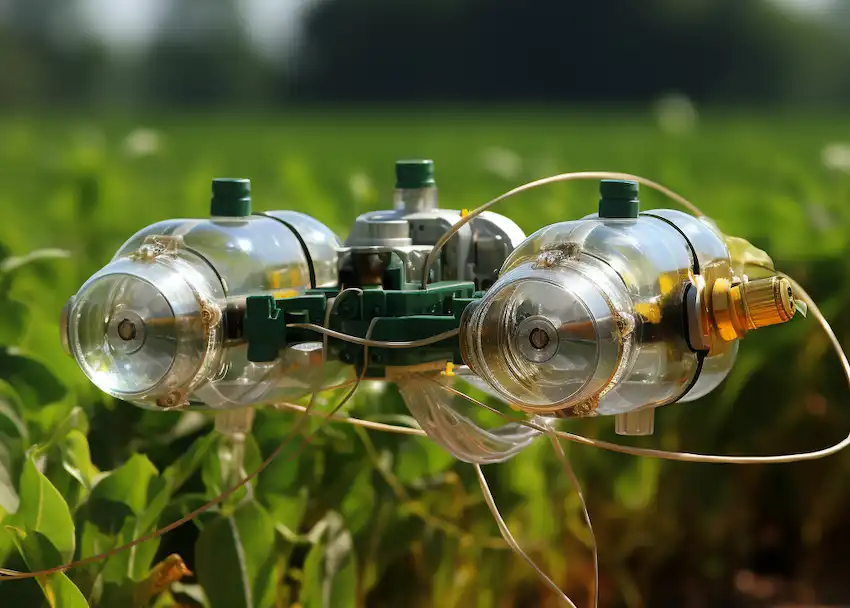Creating an efficient and eco-friendly rotating irrigation sprinkler with an upgraded mechanical bearing system enhances both performance and durability. The mechanical bearing ensures smoother rotation and longer-lasting operation, making it a valuable improvement for any garden irrigation setup. Here’s an updated step-by-step guide to building your own rotating irrigation sprinkler with a mechanical bearing.
What You’ll Need
- PVC Pipe: For the sprinkler body and base.
- Mechanical Bearing: To facilitate smooth rotation.
- Sprinkler Head: A rotating sprinkler head or nozzles for water distribution.
- PVC Fittings: Including elbows, tees, and couplings.
- Drill and Drill Bits: For creating holes in the PVC pipe and installing the bearing.
- Screwdriver: For assembling parts.
- Pipe Cutter or Saw: For cutting PVC pipe.
- Teflon Tape: To ensure a watertight seal.
- PVC Glue: For assembling the PVC parts.
- Water Source: Such as a garden hose or water spigot.
Steps to Build Your Rotating Irrigation Sprinkler
1. Design and Cut the PVC Pipe
- Determine Dimensions: Decide on the size and shape of your sprinkler. A typical design includes a vertical stand with a rotating arm.
- Cut the Pipes: Using a pipe cutter or saw, cut the PVC pipe into the following pieces:
- Base: A section for the base of the sprinkler.
- Stand: A vertical section that holds the rotating arm.
- Rotating Arm: A horizontal section that will hold the sprinkler head.
2. Prepare the Mechanical Bearing
- Select Bearing Size: Choose a mechanical bearing that fits the diameter of your PVC pipe and is compatible with the rotating arm.
- Install Bearing: Drill a hole in the center of the PVC pipe section where the rotating arm will attach. The hole should be slightly smaller than the bearing’s outer diameter to ensure a snug fit. Press or fit the bearing into the hole.
3. Assemble the Sprinkler Body
- Attach the Bearing: Secure the bearing in place with PVC glue if needed, ensuring it is properly aligned and centered.
- Assemble Base and Stand: Connect the base section to the vertical stand using PVC fittings. Ensure all connections are watertight by applying Teflon tape and PVC glue.
- Attach the Rotating Arm: Insert the rotating arm into the bearing, ensuring it rotates smoothly. The arm should be horizontal and well-balanced.
4. Install the Sprinkler Head
- Attach Sprinkler Head: Secure the sprinkler head or nozzles to the end of the rotating arm. Ensure the head is firmly attached and positioned correctly for optimal water coverage.
- Test the Rotation: Before finalizing the setup, test the rotation of the arm to ensure it moves smoothly and evenly. Adjust the sprinkler head if necessary to achieve the desired spray pattern.
5. Connect to Water Source
- Attach Hose or Pipe: Connect the base section of the sprinkler to your water source using a garden hose or a direct pipe connection.
- Check for Leaks: Turn on the water source and check all connections for leaks. Tighten or adjust fittings as needed.
6. Final Adjustments
- Adjust Spray Pattern: Fine-tune the sprinkler head to ensure even water distribution across your garden.
- Secure the Sprinkler: If needed, anchor the base of the sprinkler to the ground or stabilize it with stakes to prevent movement during operation.
Benefits of Using a Mechanical Bearing
- Smoother Operation: The mechanical bearing allows for smoother and more efficient rotation of the sprinkler arm.
- Increased Durability: Bearings reduce friction and wear, extending the life of the sprinkler.
- Improved Performance: Enhanced rotation improves water distribution and coverage.
Maintenance Tips
- Regular Inspection: Check the bearing and other components regularly for wear and tear. Replace parts as needed.
- Clean Nozzles: Periodically clean the sprinkler head to prevent clogs and ensure optimal water flow.
- Winter Care: In colder climates, remove and store the sprinkler system during winter to prevent damage from freezing.
By incorporating a mechanical bearing into your rotating irrigation sprinkler, you enhance its efficiency, reliability, and longevity. This eco-friendly upgrade ensures that your garden receives consistent and effective watering, contributing to a healthier and more vibrant garden.

